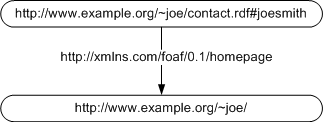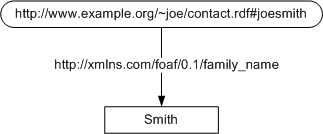Resource Description Framework
Resource Description Framework (RDF) is a framework for representing information about resources in a graph form. Since it was primarily intended for representing metadata about WWW resources, it is built around resources with URI.
Information is represented by triples subject-predicate-object in
RDF. An example of a triple is shown in the figure
below. It says that
"Joe Smith has homepage http://www.example.org/~joe". All elements
of this triple are resources defined by URI. The first resource
http://www.example.org/~joe/contact.rdf#joesmith (subject)
is intended to identify Joe Smith. Note that it precisely defines how to get to
a RDF document as well as how to get the joesmith RDF node in it.
The second resource http://xmlns.com/foaf/0.1/homepage
(predicate) is the predicate homepage from a FOAF (Friend-of-a-friend)
vocabulary. The last resource (object) is Joe's homepage
http://www.example.org/~joe/.

RDF triple (in graph representation) describing Joe Smith -
"Joe has homepage identified by URI http://www.example.org/~joe/"
All of the elements of the triple are resources with the exception of the last element, object, that can be also a literal. Literal in the RDF sense is a constant string value such as string or number. Literals can be either plain literals (without type) or typed literals typed using XML Datatypes. An example of literal usage is illustrated in the triple shown in the figure below.

RDF triple (in graph representation) describing Joe Smith - "Joe has family name Smith"
(c) Marek Obitko, 2007 - Terms of use
